
never ceases to captivate our hearts
Beautiful items that give you a feel of Okinawa's unique climate
Like crafts created from a bright and rich natural environment.
The creators are also strong, healthy and generous.
Born by connecting people
The connection between Okinawan makers and fennica
I want to convey this to people who pick it up and use it.
Introducing Okinawan makers

never ceases to captivate our hearts Beautiful items that give you a feel of Okinawa's unique climate Like crafts created from a bright and rich natural environment. The creators are also strong, healthy and generous. Born by connecting people The connection between Okinawan makers and fennica I want to convey this to people who pick it up and use it. Introducing Okinawan makers |
``Matsuda Yoneji Kobo'' is a Yomitan Yamayaki Kitagama produced by four potteries.In addition to the popularity of the pottery that is easy to use on a daily basis, the owner of the kiln, Mr. Yoneji Matsuda, is drawn to his passion for pottery and his personality, and aspiring artisans who want to become independent We are gathering. About seven years ago, his own son, Kengo, also started training. We create products with flexible ideas while respecting tradition.

Warm up the past and learn about the new
Okinawan pottery has been around since the days of the Ryukyu Kingdom. While inheriting this tradition, Matsuda Yoneji Kobo continues to work with the desire to create even better products. ``Creating new things while looking at old things, learning from the past and new things.Although things have been around for a long time, we are constantly trying to create something better.``Easy to use'' changes with the times, so we recognize the value and leave it as wonderful. I think we have to distinguish between what should be done and what should be changed.''Kengo, like his master, said, ``While I refer to old Okinawan pottery that I like, I don't want to just copy it.'' Instead, I want to place importance on arranging it to fit modern times, and I hope that people can get a sense of old Okinawa from that.''He continues to study hard every day.
Making and choosing for use
With the popularity of Yachimun in recent years, Kitagama's name is now nationwide. Its popularity has also spread to younger generations. Regarding what people of his generation have in their hands, Kengo says, ``I don't use it because it's popular or because it's a brand, but because I think it's a good tool to live with, and I use it because I want to use it.'' I would be happy if people would think that way.''


The master himself says, ``After all, we are making products to be used.That is the main premise.With that in mind, we strive to make what we make today better than yesterday.'' The generously decorated vessels will brighten your heart just by displaying them on your dining table. ``I believe that the work you do shows in your work.If you work while having fun, it will show in your energetic atmosphere.
I hope more people will become interested in pottery and want to use it or make it. ” Kengo said with strong words. ``The best thing I can think of is that pottery is not difficult.I want to work to make pottery more popular, and I want to continue teaching my work to my apprentices so that I can continue to make pottery that will carry the next generation.'' I want to do that,” said Yoneji. The lineage of Okinawan pottery continues through forward-looking manufacturing.
Koji Matsuda created Kitagama with his twin brothers Yoneji Matsuda, Masato Miyagi, and Masamori Yonabaru, and is now one of Okinawa's leading artisans. This is an unusual style for Okinawan kilns, where Mr. Koji is in charge of the molding and his wife does the painting. Based on reliable techniques, the colorful and carefree paintings are blooming.
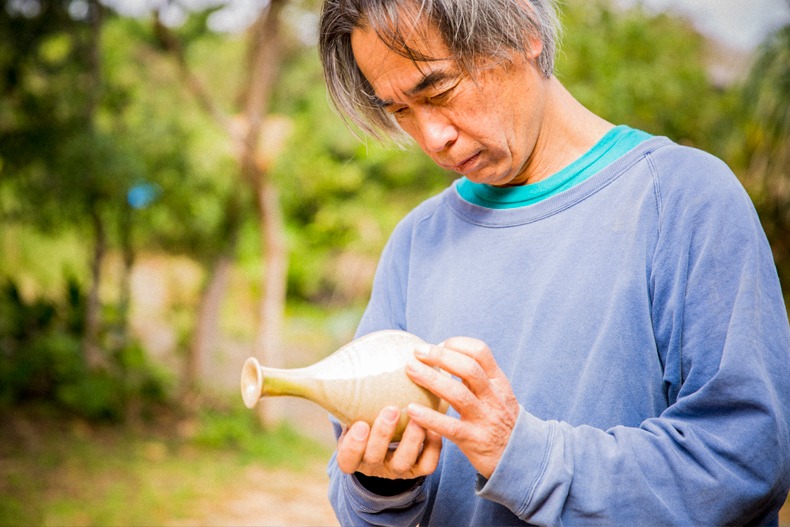
Thank you for using it
Like his older brother Yoneji's workshop, Kyoji's pottery is extremely popular in Okinawa. While many different pottery makers create pottery in their own styles, many of the pieces made by Mr. Kyoshi have a traditional style that inherits traditional designs. ``Normally, people would try new things while studying, right?I can't do that myself (lol)It doesn't matter if my skills are ugly, but I have to face the soil of Okinawa. I feel like it's our destiny. Sometimes I think it would be easier if we incorporated good shapes and things from the mainland. So I'm really grateful that they're using it. I'm really grateful that they're using it. People who buy and use what I create while searching for the right answer are supporters."
Facing the soil of Okinawa
The main feature of Yachimun is that it is made from red clay, which contains a lot of iron, as a base, and then the decoration is made of white clay. Mr. Koji has an extraordinary feeling for soil, saying, ``Soil comes first, then baking, and finally color and shape.Color and shape are artificial, and soil is something that humans can't control.'' I have. That's because the soil of Okinawa helped me find who I am.
“Before I started making pottery, I instinctively loved making and drawing, so I left Okinawa and went to Tokyo to study design, but I kept thinking about who I am as a person.Okinawa I thought that I could become an Okinawan person by studying the culture and making pottery, so when I became an apprentice to Mr. Sanekyo Omine of Ishimine Kiln, the teacher said, ``Okinawa people make pottery with Okinawan clay.'' When I heard him say, ``Isn't it wonderful to cook ingredients grown in Okinawa and eat them in this bowl?'', I was very moved and thought that this was what I was looking for. hand.
40 years have passed since then. I think that my life as a potter was good for me as well. ” I look back. Face the soil, trust it, and pour your heart into it. Mr. Koji hopes that this will be passed down to the next generation.
Mayan Yamada, who opened a kiln in Yomitan Village in 1979 and creates pottery, is one of Okinawa's leading makers and has held solo exhibitions both in Japan and in the United States. Although based on tradition, the dynamic brush strokes and eye-catching colors created from a unique sensibility are all works that bring out the energy of Okinawa and add color to your daily life. .

The workings of nature are a treasure trove of creativity beyond human knowledge.
Her parents were painters, and she had paintbrushes and clay around her from an early age, so she developed an interest in pottery while playing. Since then, akae can be said to be synonymous with Mayan, who has been making pottery for 50 years. Although it is more expensive than other items because it requires more effort, many people instinctively feel the color and modern atmosphere, making it very popular at fennica. There are many fans of Maman's Akae.

The source of inspiration is the natural scenery of Okinawa. ``For example, in Okinawa there is a plant called croton, which has red and yellow leaves, and when it withers, it turns black and bright red spots appear. A bright red circle is modern.That's why I always remember that aspect of the natural world.''People may be fascinated by the richness that naturally oozes out from the vessels that are created in this way.

A magnificent worldview that emerges from what we cultivate every day
Similar to red painting, the basis of manufacturing is what we have seen and felt in our daily lives. ``I often tell my students that sweeping is important.When I was cleaning the garden, I noticed that leaves were falling.The movement of the wind changes depending on the day, so when I think about how to sweep, the movement of the leaves changes. Depending on how you put it in, it can leave behind patterns of clouds and waves, which can be fun. You can see all sorts of things in it. That goes into your memory and influences what you create."
``I don't have any ideas.I don't seem to have any inspiration.When I accumulate things I see and feel like fragments, they come out quickly and influence me when I create something.That's why. , you guys, if you stay absent-minded, nothing will come out of you (lol). Try drawing a picture over and over again. If you keep drawing over and over again, unconsciousness will come into it.
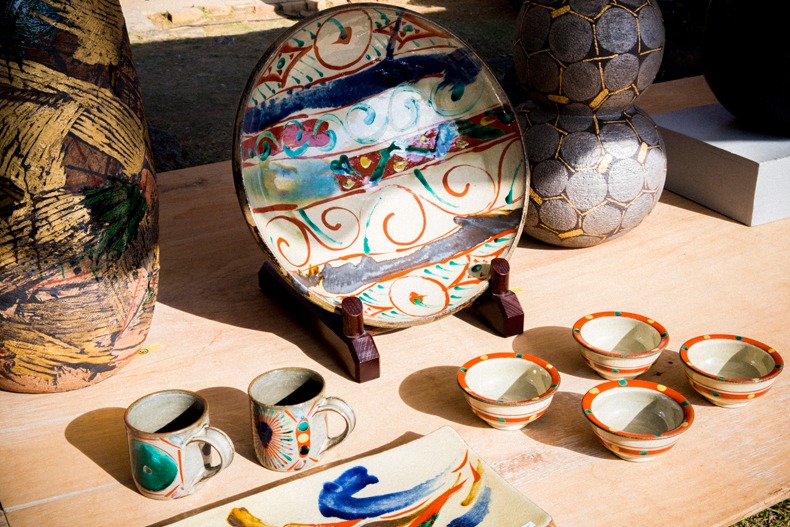
You can't do it consciously; your body remembers how to move the brush without thinking about it, and when it starts moving, you can move forward. ”
Maman is somewhat philosophical and artistic. Here you can experience a unique world where you can feel the universe.
Goldsmiths have a history dating back to the Ryukyu Dynasty. ``Goldsmith Matayoshi'', which has its roots in the first generation who went to China on the orders of the royal government in 1509 to acquire goldsmithing skills and became a purveyor to the royal government, produces zifa (hair ornaments), tassel rings, knot rings, etc. The seventh generation, Kenjiro Matayoshi, continues to preserve the irreplaceable shape and culture that has continued since the dynasty era.
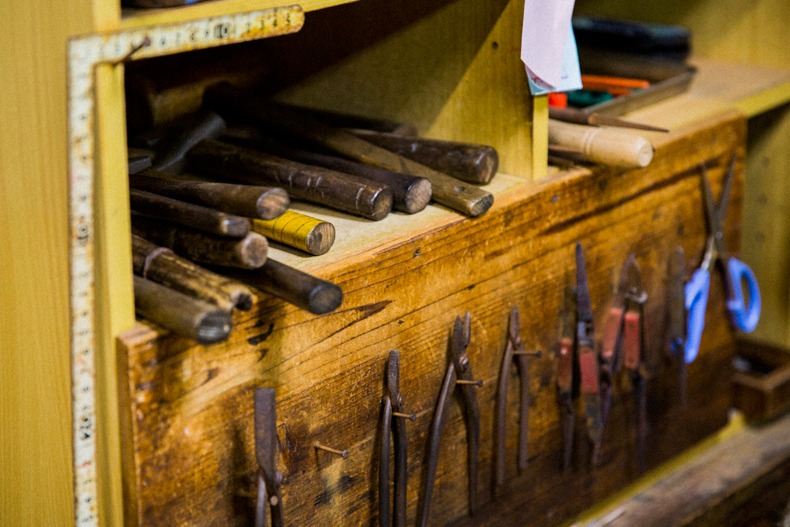
Protecting the light of Ryukyu culture and craft culture
When you visit Goldsmith Matayoshi and look at the workshop, the first thing you see are the many well-used tools. Most of them have been passed down to us from our father, the 6th generation Mr. Masayoshi, who worked hard to revive goldsmithing during the post-war period. ``When I was having trouble finding a successor, I wondered what would happen to the tools my father used when he passed away.Tools are meaningless unless they are used.And my father's work will continue to be shaped by what he made. This is a job that will remain as a legacy.Since it is a part of Ryukyu culture and a part of craft culture, I thought that someone had to do it in order to pass it on, so I said to my father, ``I'll do it.'' At the age of 40, Kenjiro, who had previously been working in another job, entered the goldsmith industry, determined to carry history on his shoulders.
Meeting people through goldsmithing
``I'm sitting here, and I've never left here. I have a tool here, I hit it here, I put it on fire, I put water on it, and I repeat this process. It's completed without even stepping outside.'' That's why I think this job is all about meeting people. I go out of my way to visit the workshop and get what they want, and the work is completed, so I naturally get involved."
Kenjiro humbly says that it's not the things he creates that are great, but the work that allows him to meet people.
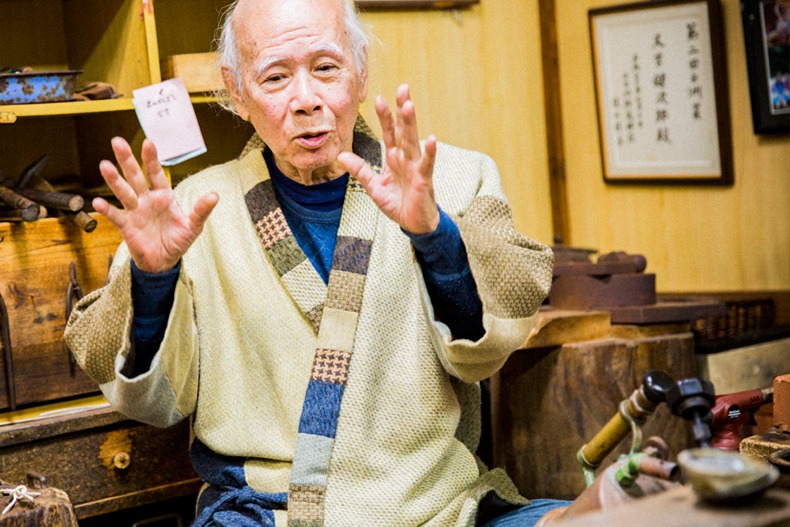
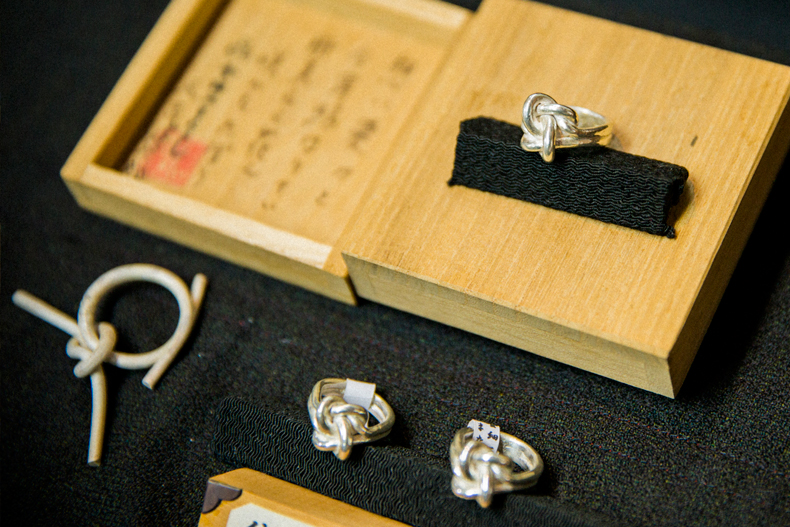
The knot ring, which is a standard item at fennica, was once discontinued, but was restored by his father, Masayoshi, from sketches owned by Keisuke Serizawa and Shiko Munakata. The knot of overlapping silver wires seems to represent the encounter and bond between a man and a woman, and many people seek them out in pairs.
``I think of a knot ring as a kind of matchmaking by tying together two silver rings.``Tonight, our feelings are tied together, and the chimuchuraku flowers are blooming.''This is a sign of mutual love. It means "please make a beautiful flower bloom because it's a ring."I would like to add these words to the customers by adding them to the Ryukyu song."When I saw the ring, I realized that I wanted to wear it and actually held it in my hands. This is also a “knot”. Kenjiro continues his work today, drawing on the ``knots'' that remain after being handed over to other people.
Ryukyu glass began in the middle of the Meiji era, and after the war, was made from empty cola and liquor bottles drunk by US troops stationed there. One person who is passing on this history to the present day is Kiyoharu Matsuda of Glass Studio Seiten. Facing the furnace that emits heat, you can quickly wrap the syrup-like glass around the blowing rod, and feel the warmth and strength that can only be achieved by handcrafting the beautifully formed glass.
Being made of traditional Ryukyu glass
Ryukyu glass started out as recycled glass made from discarded bottles, but today there are many workshops that purchase raw glass and make it, so it is starting to lose its former appearance. Meanwhile, ``Glass Studio Seiten'' is making glass that is based on the original Ryukyu glass.
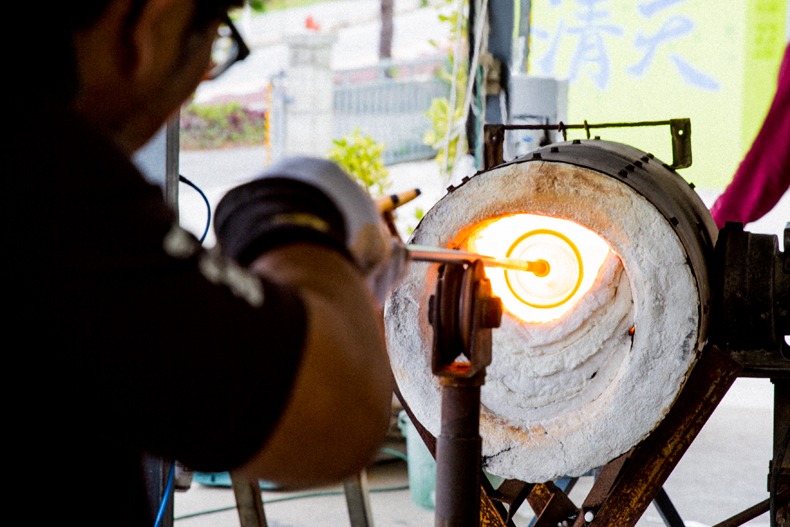
``During my training at several workshops, I came into contact with a variety of raw materials, including window glass, raw glass, and crystal glass.However, Ryukyu glass has a history that began with discarded bottles, so I was able to work with various materials such as window glass, raw glass, and crystal glass. It was time to start with bottles. Since then, I've been using awamori bottles for 20 years.''The rustic colors and flavors, such as clear, moss green, and brown, are the same colors as recycled glass. In the case of purple or blue glass, we use an empty bottle mixed with a small amount of medicine to create the color.
Handmade shapes that cannot be produced by machines
Seiten's glass has a thickness and weight that fits comfortably in the hand, something that cannot be achieved with industrial products, and a generous feel that comes from air-blowing. ``In the past, I wanted to make glass that was thinner and more beautiful than what was made by machines, and I wanted to go beyond machines.''At that time, a business partner told me, ``Leave thinner glass to machines, and make it by hand.'' I was asked, ``Could you make something that I can feel and feel safe in my hands?''From there, I started making things that would be hard to break and have a certain thickness. We create products that are simple and considerate of the users. "If you use one item, you'll want 5 or 10 more. We want to make products that are easy to use and that you'll want to keep using." This belief may be the reason why we have repeat customers and support.
Inheriting technology will lead to further growth in your work
Since Mr. Matsuda started his workshop, he has trained people who have the desire to make glass, and so far five craftsmen have gone independent and started work in various places. ``At our school, we have a system where you learn a technique and then become independent.I like teaching, and the reason I teach is because I want to improve myself by preparing and reviewing the techniques. I also learn and it leads to my own growth.That's why I teach even if other glass studios ask me how to make glass.I'm confident that I can't surpass what I make, and I think that's what technique is all about. Mr. Matsuda's unwavering confidence in his work and his never-ending desire to improve support the tradition of Ryukyu glass, which is passed down from hand to hand and continues to be passed on to future generations.

Muroo Taniguchi trained under Yomitan Yamayaki Mayan Yamada, and in 2010 opened his home and studio, Murou Gama, in Nago City. While inheriting the quality of Okinawan pottery that he was fascinated by, his vessels are bright and modern, making use of his own unique taste. As a young Okinawan potter, he is gaining popularity in the Tokyo metropolitan area.
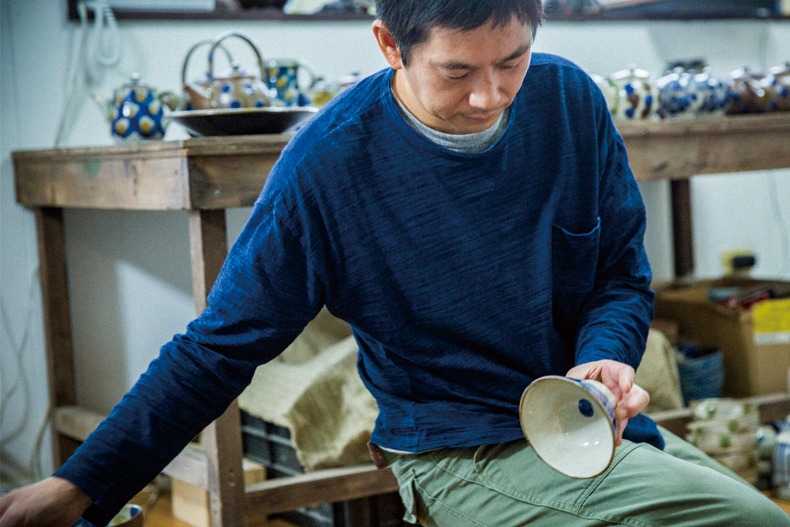
Don't think too much and be honest with yourself
Mr. Taniguchi naturally developed an interest in pottery by visiting potteries and antique stores from a young age, following his father, who is a painter who loves folk art. After majoring in pottery at university in the United States and returning to Japan, he joined Maya Yamada's workshop at the age of 26, continued his training, and became independent for eight years. Mr. Taniguchi humbly says, ``I still haven't fully digested what I learned at Yomitan, so I'm doing something different from other people, but I'm still at the stage where I can copy the shape of an antique and make it my own.'' For the past few years, I have been exhibiting my works in public exhibitions, and when I submitted them to the national exhibition last year, I thought, ``I had to take my technique to the next level and express Okinawan work. Mr. Koji (Matsuda) told me, ``Do what you like at the national exhibition and don't worry about Okinawa.'' The work I submitted with that feeling was selected for the first time.
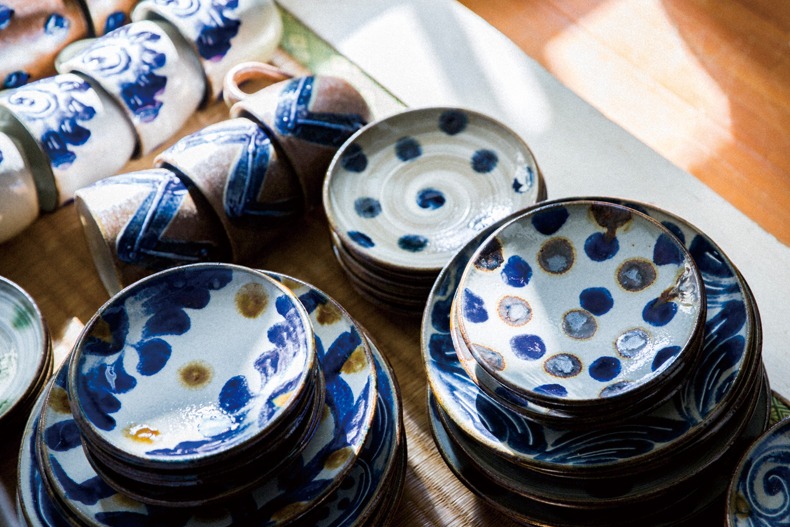
Aim for your own manufacturing style
The true value of Mr. Taniguchi's vessels is the bold painting of gosu and candy glaze with good color, and the easy-to-use shapes. Part of the fun is discovering new items that are created from time to time. ``I think there are many expressions that I won't be able to express as I get older, so I'm trying to do what I want to do as if this is my last chance.'' Currently, she uses a gas kiln and works at a high pace four to five times a month. Days spent firing the kiln and honing my skills.
Currently, he is firing in a gas kiln, but says, ``I've always wanted to use a maki kiln, and in the future I would like to change my style of making things a little more in the direction that I want.I fire the kiln once every two months. "I want to work hard at the pace of burning a fire," he says, and is searching for ways to make things that he is satisfied with.
Kaori Nakazato of ``Pottery Studio Fuukahara'', who opened a kiln in Nakijin village's rich natural land after training at Yomitanyama ware Kitagama ``Matsuda Yoneji Kobo'', is a notable female maker. We value the traditions cultivated in Yomitan, and place emphasis on having people use them.Usageware for everyday use. An increasing number of people are seeking Nakazato's pottery, attracted by the gentle atmosphere that lies within its strength.
A path to pottery made with a competitive spirit
Mr. Nakazato went out on his own after spending five years working at a pottery studio in the prefecture and eight years at Matsuda Yoneji Kobo. Since it is a difficult job where everything from preparing the soil is done by hand, there are many people who give up on the training midway through and quit.However, ``I don't like to lose.It was fun to take each step one by one.'' I was so busy every day that even though I had things to do, I couldn't see the goal.I wanted to do this, I wanted to do that, I wanted to learn something.''I kept a positive attitude and worked diligently to improve my skills. I learned a lot from Mr. Yoneji's teachings, such as looking at old things and creating your own pottery based on what you feel, and his style of craftsmanship. Looking back on his time as an apprentice, he says, ``I'm really grateful to have been nurtured by him.''
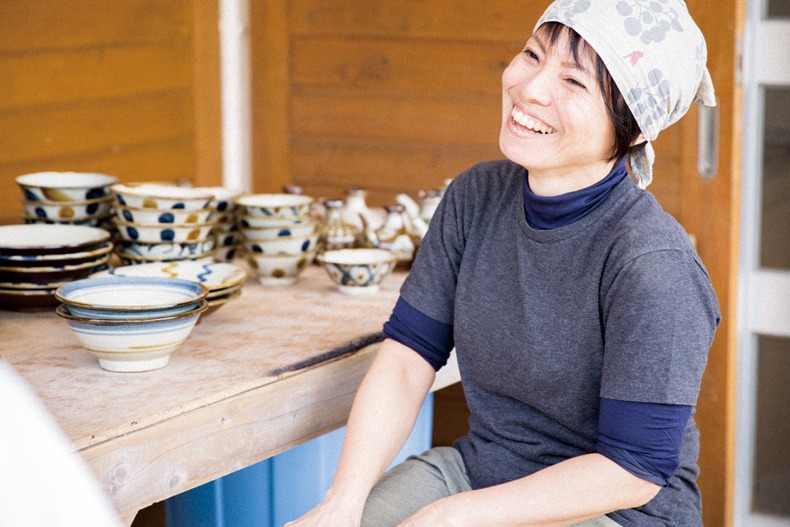
What I create is my true self
``Ever since I started my own business, I've realized that it's interesting how I can capture the feeling of ``like'' in people who use and buy my products, which I don't have myself,'' says Nakazato. The painting has a rhythmic and refreshing feel to it.
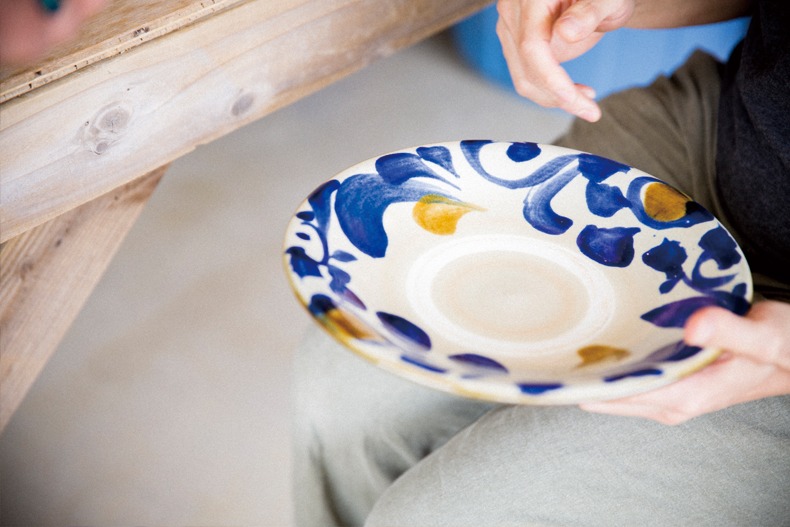
``I'm trying not to show anything original, but I'm surprised to see the lines and shapes appearing.I feel embarrassed because I feel like my true self is there, but I draw the same arabesque.'' But I guess I have my own rhythm in all of them (lol).'' Even so, I was greedy and said, ``If I come across something new and find that I like it, I can absorb that preference and make it my own.'' Mr. Nakazato pursues his own style. ``I want to work even harder on the red glaze that I tried for the first time,'' he said, continuing to make pottery today.
information
『2018 OKINAWAN MARKET』
We will be holding the 2018 OKINAWAN MARKET, which will feature a wide range of Okinawa-related crafts, including the works of the makers introduced in this special feature.
Event period: March 2nd (Friday) – March 11th (Sunday), 2018
Holding store: International Gallery BEAMS (Harajuku) 2F
Click here for event details

